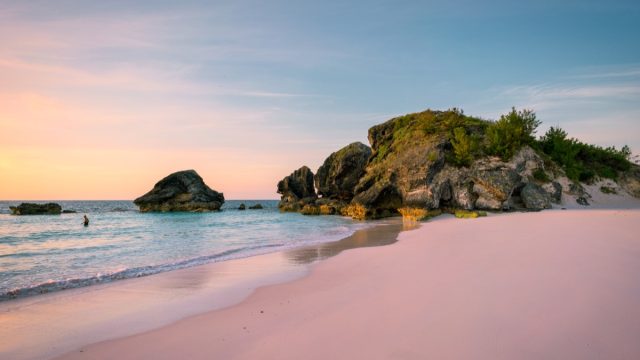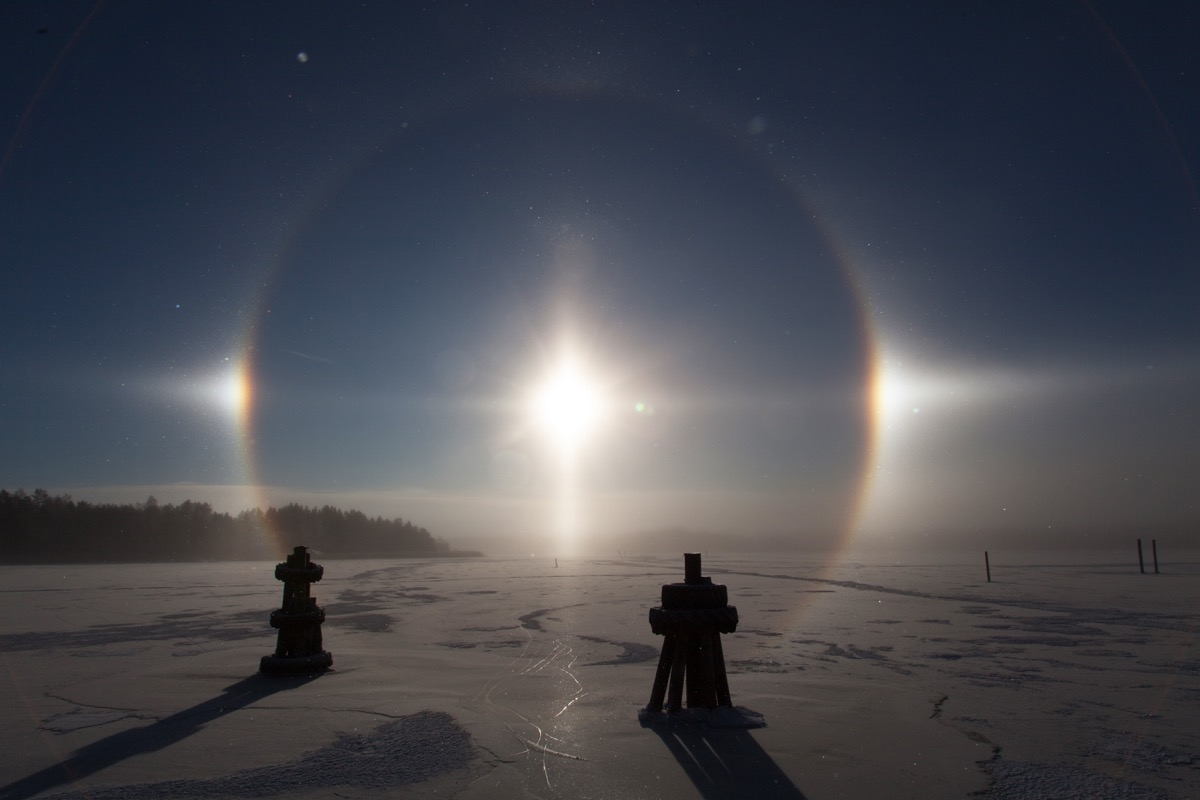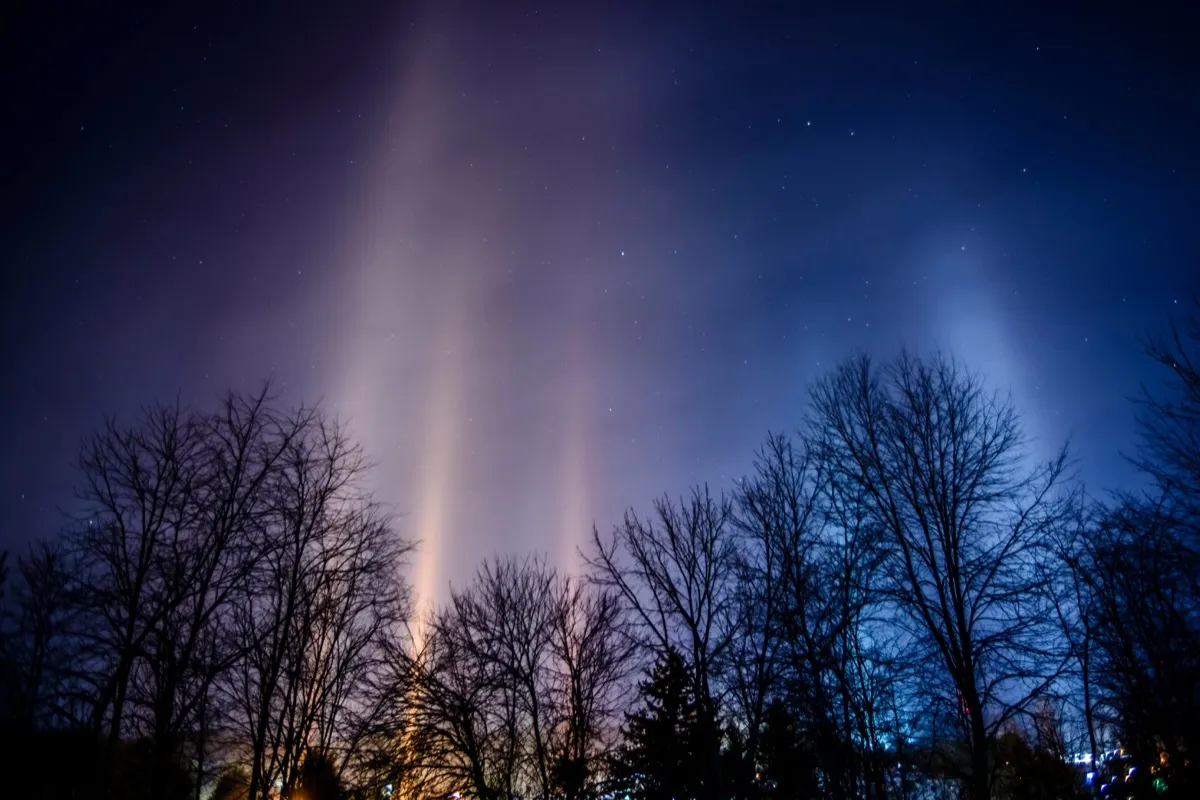30 Gorgeous Photos of Rare Earth Events

Some of the most beautiful sights in nature are unfortunately also the most rare. For example, once a year, the sun hits Horsetail Falls in Yosemite National Park at just the right angle to make the entire waterfall look like it’s on fire. And for two weeks each spring, fireflies light up the Great Smoky Mountains National Park with a stunningly luminous mating ritual. And don’t even get us started on fire rainbows!
Since the chances of you seeing some of the most breathtaking events on planet Earth are so rare, we’re here to help ease your curiosity. We’ve rounded up photos of the 30 most gorgeous unique events in the world. Sure, a great picture is worth a thousand words; but these will leave you speechless.
1
Rainbow Eucalyptus Trees; Oahu, Hawaii

This technicolor tree trunk isn’t some avant garde art display. It’s totally au natural. These eucalyptus trees are only native to areas with moist tropical settings—places like New Guinea, Indonesia, and the Philippines, according to the Missouri Botanical Garden. When the rainbow eucalyptus tree is grown outside of these settings, it grows much shorter, and the bark is far less vividly colorful. So, to truly get the full Pollock experience, so to speak, you’ll have to book a flight to somewhere in the Pacific. (The above tree is in Oahu, Hawaii.)
2
Penitentes; Andes Mountains, South America

Penitentes are found only on high-altitude glaciers—where the sun is bright, the temperature cold, and the dew point below freezing. (This photo, for instance, was taken on a glacial ridge in the Andes Mountains.) These spiky sculptures form thanks to a process called sublimation—when the sun’s rays turn ice into water vapor without melting it first, entirely skipping the liquid stage of the solid-to-gas evaporation process.
If all that sounds otherworldly to you, well, it might be. According to the American Institute of Physics, some scientists think that penitentes could be found on Europa, one of the moons circling Jupiter! We’ll find out more when the Europa Clipper probe launches in June 2023.
3
Frozen Bubbles; Abraham Lake, Canada

These picturesque frozen bubbles are most famously found in Lake Abraham, an artificial reservoir just north of Banff National Park, in Alberta, Canada. They’re made up of methane, a flammable gas that forms in bodies of water when dead organic matter worms its way in. Every winter, so-called “bubble hunters” flock to the lake to get a glimpse of the frozen pockets. Don’t worry, though, because walking on the surface is totally safe: In mid-winter, the ice can apparently be as thick as two feet.
4
The Spotted Lake; Osoyoos, Canada

The Spotted Lake is a polka-dotted body of water in the desert of British Columbia in Canada. Since the lake contains a large number of concentrated minerals, when the warm desert climate causes the water to evaporate, mineral pockets are left behind as colorful spots. Being the only lake of its kind in the world, you’ll have to travel to Osoyoos, Canada, if you want to see it in person—and you’ll have to do so during summer, when temperatures are in the right condition.
5
Sun Dog; Trosa, Sweden.

Sun dogs are faithful companions to the actual sun, flanking either side within a 22 degree halo. These mock suns are caused by the refraction of sunlight through hexagonal ice crystals in cirrus clouds. They tend to be most visible when the sun is low on the horizon, and most common during the winter. As seen in this photo from Trosa, Sweden, many sun dogs tend to appear with an ever-so-slight red tint.
6
Nacreous Clouds; York, England

If you ever get a chance to see extremely rare nacreous clouds in person, in all their pearl-like beauty, be sure to whip out your camera—stat. These iridescent clouds form when stratosphere temperatures fall below the ice frost point, so they’re only usually seen in places like Antarctica or Scandinavia. Still, as seen in this pair of shots taken by photographer Les Cowley, they’ve been spotted in England a handful of times.
7
Giant’s Causeway; Country Antrim, Northern Ireland

When visiting the Giant’s Causeway, in Northern Ireland, you can see nearly 40,000 interlocking basalt columns, formed in hexagonal blocks along the coast. The unusual landscape was caused by volcanic activity an estimated 60 million years ago. Because of its photogenic uniqueness, the area is a huge tourist attraction and recognized as a UNESCO World Heritage Site.
8
Fire Rainbows; Tenaya Lake, California

Despite the name “fire rainbows,” this phenomenon has nothing to do with rainbows or fire. Basically, a lot of highly specific factors have to occur before you can see a fire rainbow, scientifically known as circumhorizontal arcs. These rainbow-reminiscent clouds only appear when the sun is higher than 58 degrees above the horizon and the resulting light passes through high-altitude cirrus clouds made up of hexagonal plate ice crystals, giving the sky a rainbow color. Thankfully, there are photos of this event in all its glory.
9
Desert Rose; Saraha Desert, Africa

This formation of crystal clusters may not be the type of rose you’re looking to gift on Valentine’s Day, but that doesn’t make it any less special. The desert rose, sometimes called a sand rose, pops up in desert regions—like the Sahara, where this particular formation was photographed. The rose forms via precipitation containing trapped sand particles, most commonly found in gypsum minerals.
10
Pink Sand Beaches; Horseshoe Bay Beach, Bermuda

A beautiful sand beach is one thing. But a pink sand beach? Well, that seems geologically designed for the Instagram era. So, what causes the pink hue? According to the National Ocean Service, the pink sand beaches in Bermuda form naturally through foraminifera, a microscopic organism that has a a reddish-pink shell. When foraminifera die, their shells wash ashore, mixing their hues with the sand to form the pink tint.
11
Total Solar Eclipse; Stanley, Idaho

Do you remember what you were doing on August 21, 2017? If you were like most people in the United States, you were probably attempting to view the total solar eclipse. Unlike other solar eclipses, a total solar eclipse, in which the moon completely covers the surface of the sun, is incredibly rare. They typically only take place every hundred years or so, depending on where you live, according to NASA.
12
Volcanic Lightning; Eyjafjallajökull, Iceland

Capturing a volcanic eruption is one thing. But capturing a volcanic eruption through an ice cap is something else entirely. That’s what happened in this shot, taken in Eyjafjallajökull, Iceland. The lightning above the ice cap is called volcanic lightning—and it tends to occur when ash-rich plumes interact with weather systems containing ice, according to Oregon State University.
13
Light Halo; Finland

It might appear to be a heavenly scene, but, according to the National Weather Service, the light halo captured in this photo is caused by sunlight refracting off ice crystals that are present in the clouds. As is the case in this shot, which was captured in Finland, light halos often appear as rainbows—though they sometimes appear as simple bright lights around the sun or moon.
14
Horsetail Falls; Yosemite National Park, California

Once a year, around the second week of February, the setting sun in Yosemite National Park hits Horsetail Falls at just the right angle—and makes the waterfall look more like a deluge of fire than water. And as you might expect, catching this rare scene on film has become incredibly popular: Recently, park rangers with Yosemite had to place restrictions on where and when visitors could snap photos of the falls.
15
Bioluminescent Waves; Samut Sakhon, Thailand

Bioluminescence, the biochemical emission of light by living creatures (like fireflies!), is not terribly uncommon in marine animals. But that doesn’t make this display of bioluminescent plankton in Samut Sakhon, Thailand, any less magical. According to the National Geographic Society, plankton are thought to use bioluminescence to ward off predators—and, as this spectacle proves, they can also use it to leave humans in awe. Stunning light shows like these rarely take place so close to the shore and occur even less frequently near such highly visited beaches.
16
Supercell; Harrisburg, Nebraska

Captured just outside of Harrisburg, Nebraska, this rare “supercell” eventually turned into a cluster of tornadoes that wreaked havoc on several nearby farms. According to the National Weather Service, supercells are the rarest types of thunderstorms that, due to their rotating updrafts, frequently produce violent weather such as tornadoes and hail the size of baseballs.
17
Lenticular Clouds; Varese Lake, Italy

Lenticular clouds are rare lens-shaped clouds that form on the downside of a mountain or mountain range, according to the Weather Underground. For them to form, stable, moist air must flow over the mountain or mountain range to create a series of oscillating waves. Further, the crest of the wave has to be equal in temperature to the dew point—creating the evaporation that forms the rare lenticular clouds that appear in this photo, taken in Italy.
18
Fire Tornado; South Africa

Captured during a wildfire in South Africa, this photograph shows the extent to which Mother Nature can inflict both beauty and terror. Fire tornados typically occur during wildfires, when intense rising heat combined with strong winds cause powerful columns of fire. Recently, the phenomenon was spotted in California, as wildfires ravaged parts of the state, according to a report from USA Today.
19
Permafrost Explosion; Yakutia, Russia

When a sinkhole occurs in the tundra, you get what’s called a “permafrost explosion.” According to the Weather Channel, these permafrost explosions are likely caused by warmer temperatures in the Arctic. The explosions occur when high-pressure gasses meet warmer temperatures—and now that they’re happening more frequently, they’re beginning to worry scientists. Here’s one that took place in Siberia.
20
Snake Breeding Festival; Manitoba, Canada

Every spring, from late April to late May, some 3,000 people flock to Manitoba, Canada, to catch the annual mating ritual of its 7,500 red-sided garter snakes. The province has the largest concentrated population of the snakes in the world. Visit if you dare!
21
Waterspout; Malapascua, Philippines

Just like land tornadoes, waterspouts—tornadoes that form over bodies of water—are typically associated with severe thunderstorms and serious destruction. In the United States, they occur most frequently over the Great Lakes, according to the National Oceanic and Atmospheric Administration. This one was captured off the coast of Malapascua, an island in the Philippines.
22
Pando Aspen Grove; Fishlake National Forest, Utah

You might be wondering what’s so rare about a bunch of trees. But the thing is, this isn’t a bunch of trees—it’s one tree. Researchers have discovered that the 106 acres of trees in the Pando aspen grove at the Fishlake National Forest in Utah are the result of just one single root system. Scientists call it the single most massive living organism known on Earth.
23
Synchronous Fireflies; Great Smoky Mountains National Park, Tennessee

For approximately two weeks in May and June, the thousands of synchronous fireflies who have made a home within the confines of Smoky Mountains National Park in Tennessee begin their mating ritual. And, as you can see, it’s one of the most breathtaking sites in the world. The fireflies flash various shades of green-yellow and blue, according to the National Park Service.
24
Reflecting Lake; Salar de Uyuni, Bolivia

No, no, this person isn’t walking on water. In fact, there’s no lake in this photo at all. The image was captured at the world’s largest salt flat, Salar de Uyuni in Bolivia. A salt flat is an area of flat land covered with a layer of salt. During certain times of the year, nearby lakes overflow onto this salt flat, which creates a thin layer of water on its surface and makes the entire flat a reflective surface, as reported by National Geographic. And that’s what you’re seeing here—one of nature’s best optical illusions.
25
Mammatus Clouds; Nebraska

This photograph, taken in rural Nebraska, shows an example of mammatus clouds—a rare cloud formation that occurs when the clouds sink in the air. In order for these clouds to form, “the sinking air must be cooler than the air around it and have high liquid water or ice content,” according to AccuWeather. But mammatus clouds are not, in fact, a beacon of bad weather to come—so take a walk outside and enjoy them while they last.
26
Sailing Stones; Racetrack Playa; California

Of all the National Parks in the United States, Death Valley National Park is perhaps the most mysterious. Case in point: Racetrack Playa, where stones seemingly roll across the rough playa without assistance. This puzzled scientists for decades, until they finally caught the stones in action. According to Science News, an incredibly rare chain of events must take place in order for the trail seen here to form.
“First, the playa fills with water, which must be deep enough to form floating ice during cold winter nights but shallow enough to expose the stones. As nighttime temperatures plummet, the pond freezes to form thin sheets of ‘windowpane’ ice, which must be thin enough to move freely but thick enough to maintain strength,” Science News reports. “On sunny days, the ice begins to melt and break up into large floating panels, which light winds drive across the playa, pushing rocks in front of them and leaving trails in the soft mud below the surface.”
27
Light Pillars; Cowen, West Virginia

Captured in rural Cowen, West Virginia, these light pillars are actually the collective glints of millions of ice crystals, according to Atmospheric Optics. Since the light pillars take on the colors of the surrounding sun and clouds, they can appear as different colors of the rainbow.
28
Monarch Butterfly Migration; Michoacán, Mexico

Considered one of the greatest natural events on Earth, the Monarch butterfly migration from the northeast U.S. and Canada to central Mexico takes place just before winter. A photographer in Michoacán, Mexico, was lucky enough to capture this rare glimpse of the final days of the migration, which takes the butterflies two months to complete. That means they’re flying up to 100 miles a day, according to the United States Department of Agriculture.
29
Turquoise Ice; Lake Baikal, Russia

Nope, this isn’t an outtake from Frozen. It’s a photo of the deepest lake in the world, Lake Baikal in Russia. Under very specific conditions—which include just the right amount of wind, frost, and sunlight—the lake becomes covered in dazzling turquoise ice. The ice most frequently appears in March, which is when this photo was taken.
30
Lightning Storm; Brisbane, Australia

Lightning is one of the oldest observed natural phenomena on Earth, but that doesn’t make it any less remarkable. This weather is basically “a giant spark of electricity in the atmosphere” that develops due to the opposite charges in the clouds and in the air around it, according to the National Severe Storms Laboratory. “The flash of lightning temporarily equalizes the charged regions in the atmosphere until the opposite charges build up again.”
And sometimes, it happens in multiple places across the sky, as it did in Brisbane in this photo from 2017. “The sky was electric for hours, certainly more than usual storms,” one local told the BBC at the time. “It would erupt in bursts, lighting up the entire sky, then calming momentarily before continuing the electric display.” And for more on lightning, check out the 33 Insane Facts About Lightning Strikes.
To discover more amazing secrets about living your best life, click here to follow us on Instagram!